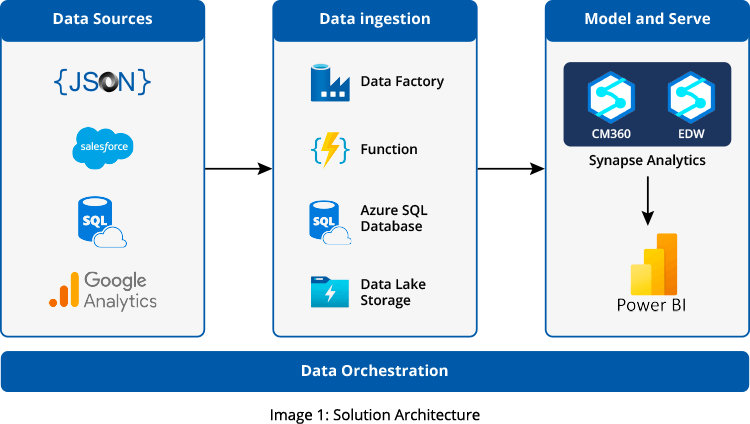Our team designed and implemented a custom community member platform to resolve the company's identity issues. The new platform can extract click stream data from Google and Facebook, among other sources. We configured a set of data pipelines and built customer and marketing dashboards, in addition to some retail-oriented dashboards.
The data solution architecture creates a unified customer view. The data include multiple datasets originating from online and in-store purchases, customer service calls, website visits, and the company's marketing cloud.
Our App Dev team designed a data model to store unique customer identifiers, including the first and last names, email, billing address, and opt-in email preferences, among other details. We also defined business rules to match and merge different customer identities.
After a one-time ‘Greenbook’ (the Greenbook of the Federal Reserve Board of Governors) download, we used Azure Data Factory to extract customer data from several sources on a regular schedule. The data sources include Salesforce Commerce Cloud (SFCC), Salesforce Marketing Cloud (SFMC), and Microsoft Dynamics AX for Retail. Then, we apply match and merge rules to create a unified custom database. Our solution extends the company's existing EDW and enables the reporting users to view an accurate customer count in a series of community member dashboard reports using Microsoft Power BI.

Key takeaways from our solution include:
- Detailed community member metrics: Metrics collected and correlated by the new system include a count of community members, including total members, new members, re-activated members, retained members, and omnichannel member counts.
- Comprehensive customer metrics: Other important metrics from the new dashboards include revenue, traffic, average sales, average unit retail value, items per transaction, and conversion rates. We also provide past-year comparisons and forecasts.
- Clean data provides a customer 360 view: Our system cleanses and standardizes customer data by applying match and merge rules to create a 360-degree unified customer view.
- Flexible reporting via dashboards: Business users can now view accurate customer counts in a Power BI dashboard. They can also view information on new and repeat customers by event or selected time.
- An empowered EDW system: The new initiative extends the company's existing EDW platform. Not needing to create a new system from scratch saves the company a huge amount of money.


